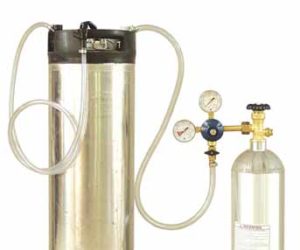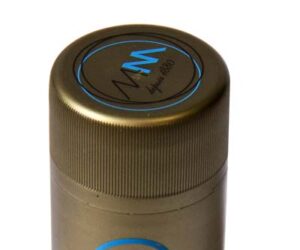
Q
I have just made my first batch of wine, a white one. Funny things have been happening to it. Everything seemed to go well with the fermentation of the wine. When it was done, I transferred it to the carboy. As I expected, the wine cleared on its own. At this point I added a little bit of wine glucose to the carboy. After the wine cleared, I filtered it with a #2 filter and the wine was crystal clear. It looked really good and man was I excited. When I tasted it, it tasted fizzy like it had been carbonated. I left it to sit a little longer in the carboy, stirred it some more to possibly get any gases out of it and the wine went cloudy again. At this point I filtered it again with another #2 filter. The bottom of the carboy had lots of sediment. It was almost as if it was still fermenting or something but it had been in the carboy now for a month. Is this fizziness a normal occurrence in whites? It also has an aftertaste that’s not too bad but nonetheless it’s got a bit of a bite plus the fizziness. Do you have any suggestions on this?
John Olendy
Oakville, Ontario
A
First of all, you need to make sure that the fermentation is finished. You do this by checking your sugars with a hyrdrometer. Fermentation for a “dry” wine is completed when the hydrometer reads 0.0 degrees Brix (or 0.990 specific gravity) and remains there for several days (or weeks). An even better way for home winemakers to check residual sugar levels is to buy the Clinitest tablets that diabetics use to determine sugar in their urine. To do the test, simply drop a tablet into a sample of wine. The wine will change color, and you compare the color against the chart provided in the kit (reading for wine, not urine!).
You might possibly be experiencing the joys of what I can only assume to be re-fermentation or secondary fermentation. This scenario can happen to red, white or rosé wines and are not necessarily a bad thing. Though it sounds like it’s a factor you didn’t expect and don’t enjoy too much.
Re-fermentation occurs when your wine has not gone completely dry (absolutely no sugar left for the yeast to ferment) and residual yeast (or ambient yeast picked up during a racking or filtration) hop in and ferment what’s left, creating the fizziness you’ve experienced. If your wine wasn’t dry when you filtered it for the first time, this is most likely what happened.Adding glucose to the carboy after the wine was filtered could have contributed to this by giving the yeast a new energy source.
Some winemakers actively encourage this re-fermentation, namely producers of sparkling wines. If you bottle the wine with a small percentage of residual sugar and bottle the wine with crown caps like a beer bottle, then you capture the carbon dioxide in the bottle itself as opposed to having it dissipate in the carboy. With the right base wine this extra fizz can make a ho-hum wine sizzle.
If your wine was dry at the time of your first filtration, then what you are most likely experiencing is carbon dioxide released by malolactic bacteria. Malolactic bacteria float around freely in the air we breathe — you don’t have to inoculate for them. These bacteria landed in your wine and began munching on the malic acid in your wine. You’d have to have a sterile filter and a sterile environment in your home winery in order to not have these guys hanging around — not even commercial wineries go that far! In fact, many winemakers actively encourage this secondary fermentation because it stabilizes the wine for bottling by pre-empting any ML bugs that might attack the residual malic acid when the wine is in the bottle. This creates fizzy wine in a bottle as opposed to fizzy wine in a carboy, which will dissipate with time. ML fermentation can also create some aromatic characteristics that are desirable for certain wine styles, namely the buttery-oaky New World Cabernet Sauvignon and Chardonnay table wines that are currently so popular.
If fizz really bothers you, you should try to ferment your wines dry and not bottle them until they’ve gone through malolactic fermentation. If you don’t like the characteristics that ML fermentation contributes to your wines and want to actively discourage ML fermentation, keep the pH below 3.30, the wine relatively cool in the cellar (below 60° F (16° C)), rack your wine cleanly during its cellaring lifetime, keep sulfur dioxide levels at 25 to 50 mg/L free SO2 and bottle as cleanly as possible (trying to avoid transferring any of the lees or too much air). You can monitor pH and sulfur dioxide with simple kits available at any home winemaking store.
Q
I have been winemaking for the last 6 to 7 years, but still consider myself a novice. I have just completed my crush for this year and am experiencing a perplexing problem. I crushed into a 500 L plastic container. The container has a valve on the bottom to release the juice. For the first time since I have been making wine, I took my SG readings from juice released from the valve. This morning I also took SG readings from the juice at the top of the tank. The readings varied dramatically (1.092 SG at the bottom and 1.070 at the top). My question is: is this normal and where is the proper location to take these readings?
Art Stein
via e-mail
A
Your question is a valid one — one that many winemakers before you have wondered about. As you have discovered, where you take a sample from in a tank can give you varying readings and you find yourself wondering which reading is the most accurate.
The specific gravity (or degrees Brix, or Baume, depending upon the scale you use) of a juice or wine is dependent upon many things, all of which have to do with the density of a solution. The denser the solution is, the higher one’s hydrometer will float, and the higher the apparent level of sugar in the juice or wine.
Since temperature affects density (the colder something is, the more dense it is), the temperature of a solution must be taken into account and corrected? in order to get an accurate reading. Typically, a fermentation is warmer on top and cooler on the bottom as the warmer fermenting juice will tend to rise. Furthermore, if your wine is fermenting on the skins, the floating “cap” of skins will be even hotter than the fermenting juice below and will create their own fermentation “micro climate.” The warmer a fermentation is, the faster it will go to completion so, naturally, if you haven’t mixed up your container in a while, a top sample will have a lower SG reading than a bottom sample. Similarly, as density is a measure of soluble solids, any solids, soluble or insoluble, in the sample will contribute to the appearance of density. This means if you take a bottom sample out of the valve in your container, it will most likely be nice and thick due to the settling of solids, even during fermentation(lees). This extra material will do nothing but make your hydrometer float higher, giving you a poor picture of what the whole vessel is doing. If you take a sample from the top, you will run into the afore-mentioned cap, rank with its own thick floaty bits, which you will have to judiciously strain out in order to get a good reading.
The solution? Mix your vessel well, take a sample from the top of the vessel (or if your vessel has a drawing-off point that’s not right on the bottom, use that) and strain it in order to get any floating skins, stems, leaves that might disrupt your reading. (A coffee filter in a kitchen strainer works great for this.) Always correct for temperature and you should have a pretty accurate picture of how your SG is doing.







